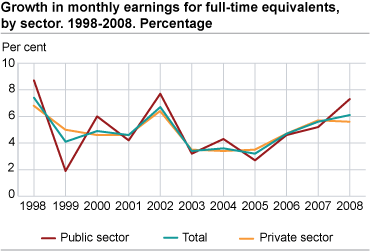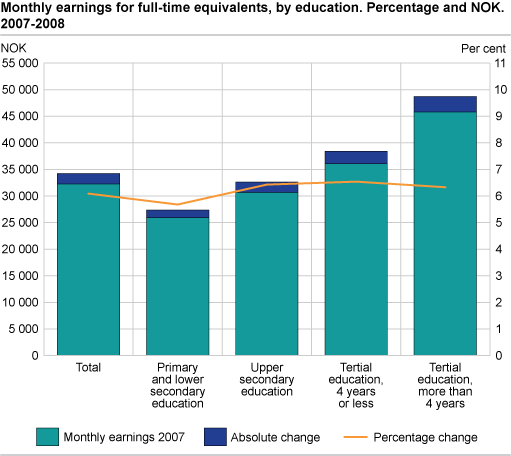Content
Published:
This is an archived release.
Monthly earnings up 6.1 per cent
Average monthly earnings for all employees in Norwegian enterprises, excluding overtime pay, were NOK 34 200 at the third quarter of 2008. This was a year-on-year increase of NOK 2 000, or 6.1 per cent.
To facilitate the comparison of the wages between full-time and part-time employees, the wages of the part-time employees are transformed to full-time equivalents, i.e. what they would have earned if they had been full-time employees. The year-on-year increase of wages from 2007 to 2008 for full-time employees was 6 per cent, to NOK 35 400. The corresponding numbers for part-time employees were 6.3 per cent and NOK 28 600.
The rest of the article considers full-time equivalents, part-time and full-time employees as a whole.
Largest rise in the public sector
Average monthly earnings of employees in the public sector rose by 7.3 per cent, to NOK 33 000, whereas the corresponding rise for the private sector was 5.6 per cent, to NOK 34 700. This is the highest percentage increase in wages for the public sector in six years. The last time a higher increase was recorded in the public sector than in the private sector was from 2003 to 2004.
Employees in municipalities and county municipalities experienced wage escalations of 8.1 per cent, or NOK 2 300, which resulted in wages in 2008 of NOK 30 100. For employees in the central government, the growth was 7.8 per cent, to NOK 35 100. By comparison, employees in public hospitals and public schools saw increases of NOK 2 100.
Growth in the private sector differed greatly by industry. Wages in the financial industry rocketed by 10.8 per cent from 2007 to 2008, to a level of NOK 47 700. In contrast, the hotels and restaurants industry edged up 3.5 per cent, to NOK 24 200.
Small changes in the wage gender gap
Women had average monthly earnings of NOK 31 100, whereas men had NOK 36 500. This was an increase of 6.6 and 5.7 per cent respectively. Women’s wages as a proportion of men’s wages climbed from 84.3 per cent in 2007 to 85.0 per cent in 2008.
Seen in a European perspective, the wage gender gap in Norway is slightly smaller than in the European Union. For the EU, the gap was 17 per cent in 2007, for Germany it was 23 per cent, and for Finland it was 20 per cent. Figures for 2008 are not yet available for countries other than Norway.
| 1997 | 1998 | 1999 | 2000 | 2001 | 2002 | 2003 | 2004 | 2005 | 2006 | 2007 | |||||||||||||||||||||||||||||
|---|---|---|---|---|---|---|---|---|---|---|---|---|---|---|---|---|---|---|---|---|---|---|---|---|---|---|---|---|---|---|---|---|---|---|---|---|---|---|---|
| EU27 member countries2 | 16 | 17 | 16 | 16 | 16 | 16 | 15 | 15 | 15 | 18 | 17 | ||||||||||||||||||||||||||||
| EU25 member countries2 | 16 | 17 | 16 | 16 | 16 | 16 | 15 | 15 | 15 | 18 | 18 | ||||||||||||||||||||||||||||
| Germany | 21 | 22 | 19 | 21 | 21 | 22 | 23 | 23 | 22 | 23 | 23 | ||||||||||||||||||||||||||||
| Denmark | 13 | 12 | 14 | 15 | 15 | 18 | 18 | 17 | 18 | 18 | 18 | ||||||||||||||||||||||||||||
| Finland | 18 | 19 | 19 | 17 | 17 | 20 | 20 | 20 | 20 | 21 | 20 | ||||||||||||||||||||||||||||
| Sweden | 17 | 18 | 17 | 18 | 18 | 17 | 16 | 17 | 16 | 17 | 18 | ||||||||||||||||||||||||||||
| Norway | 16 | 16 | 17 | 17 | 17 | 16 | 16 | 16 | 16 | 16 | 16 | ||||||||||||||||||||||||||||
| 1 |
Gender pay gap is given as the difference between earnings of male employees and of
female employees as a percentage of earnings of male employees. |
| 2 | Eurostat estimate. |
| Source: Eurostat. | |
| For more information: http://www.epp.eurostat.ec.europa.eu | |
Increase in the number of women with college or university degrees
One of the reasons for the increase in the average monthly earnings and the dwindling of the gender wage gap is probably the changes in the education level and structure. The proportion of employees with higher education has increased from 33 per cent in 1997 to 38 per cent in 2008. The growth is mainly due to the increase in the number of women with college or university degrees. In 1997, one out of three women had higher education, while in 2008 the figure was two out of five. For men, the share has remained stable for the whole period, at one out of three. The public sector employs a disproportional number of college and university graduates. Over fifty per cent of employees in this sector have higher education, whereas about one out of four do so in the private sector.
Average monthly earnings of employees with more than four years of university or college education were NOK 48 700 in 2008. This was a year-on-year rise of 6.3 per cent, or NOK 2 900. For employees with college or university education of four years or less the increase was 6.5 per cent, or NOK 2 400, to NOK 38 400. The largest group in the workforce is the high school graduates, with earnings of NOK 32 600, which was a rise of 6.4 per cent or NOK 2 000. Workers with only primary and lower secondary education had average monthly earnings of NOK 27 400, up 5.7 per cent or NOK 1 500 from the previous year.
Hence, the highest educated group of employees had NOK 21 300 or 78 per cent higher monthly earnings than the lowest educated group in 2008. In 1997 the difference was 60 per cent.
The difference is larger in earnings between the highest and the lowest educational levels for men than for women, and the difference has increased over time. In 1997 this difference was NOK 10 700 or 57 per cent for men, and NOK 8 600 or 54 per cent for women. In 2008 the corresponding figures were NOK 24 000 and 84 per cent for men, and NOK 16 900 and 66 per cent for women.
About the statistical basisThe statistics are based on information from a sample of enterprises with a total of 1 505 405 employees in the third quarter of 2008. They cover all industries except for agriculture, hunting and forestry. The data for these statistics have not been collected separately, but through previously published statistics for the individual industries. According to figures from the national accounts for the third quarter of 2008, the statistics cover about 2 509 000 employees. The figures for 2007 have been revised. |
Tables:
- Table 1 Average monthly earnings for full-time equivalents, by sector, sex and working hours per 3rd quarter 2007 and 2008. NOK and per cent
- Table 2 Average monthly earnings for full-time equivalents, by working hours and section per 3rd quarter 2007 and 2008. NOK and per cent
- Table 3 Full-time employees in private sector. Average monthly earnings 2005-2008. NOK and percentage change
- Table 4 Full-time employees. Average contractual working hours per week and average monthly earnings, by section. 2005-2008. Hours and NOK
Additional information
Contact
-
Arbeidsmarked og lønn
E-mail: arbeidsmarked@ssb.no
-
Knut Snellingen Bye
E-mail: knut.snellingen.bye@ssb.no
tel.: (+47) 40 81 13 26
-
Magnus Berglund Johnsen
E-mail: magnus.johnsen@ssb.no
tel.: (+47) 40 90 23 75
-
Fredrik Steinrem Edelmann
E-mail: fredrik.edelmann@ssb.no
tel.: (+47) 40 90 24 60
-
Knut Håkon Grini
E-mail: knut.grini@ssb.no
tel.: (+47) 48 20 51 63


